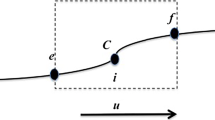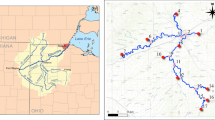Abstract
This study is driven by the question of how quickly a solute will be flushed from an aquatic system after input of the solute into the system ceases. Simulating the fate and transport of a solute in an aquatic system can be performed at high spatial and temporal resolution using a computationally demanding state-of-the-art hydrodynamics simulator. However, uncertainties in the system often require stochastic treatment and risk-based analysis requires a large number of simulations rendering the use of a physical model impractical. A surrogate model that represents a second-level physical abstraction of the system is developed and coupled with a Monte Carlo based method to generate volumetric inflow scenarios. The surrogate model provides an approximate 8 orders of magnitude speed-up over the full physical model enabling uncertainty quantification through Monte Carlo simulation. The approach developed here consists of an stochastic inflow generator, a solute concentration prediction mechanism based on the surrogate model, and a system response risk assessment method. The probabilistic outcome provided relates the uncertain quantities to the relevant response in terms of the system’s ability to remove the solute. We develop a general approach that can be applied in a generality of system configurations and types of solute. As a test case, we present a study specific to salinization of a lake.









Similar content being viewed by others
References
Blatman G, Sudret B (2010) Efficient computation of global sensitivity indices using sparse polynomial chaos expansions. Reliab Eng Syst Saf 95(11):1216–1229
Bliznyuk N, Ruppert D, Shoemaker C, Regis R, Wild S, Mugunthan P (2008) Bayesian calibration and uncertainty analysis for computationally expensive models using optimization and radial basis function approximation. J Comput Graph Stat 17(4):270–294
Borgonovo E, Castaings W, Tarantola S (2012) Model emulation and moment-independent sensitivity analysis: an application to environmental modelling. Environ Model Softw 34:105–115
Boylen C, Eichler L, Swinton M, Nierzwicki-Bauer S, Hannoun I, Short J (2014a) The state of the lake: thirty years of water quality monitoring on Lake George. Report
Boylen CW Eichler L, Swinton M, Nierzwicki-Bauer S, Hannoun I, Short J (2014b) The state of the lake: thirty years of water quality monitoring on Lake George. Technical report, Darrin Fresh Water Institute and Department of Biological Sciences, Rensselaer Polytechnic Institute
Chapra SC, Reckhow KH (1983) Engineering approaches for lake management, vol 1. Butterworth, Boston
Ciriello V, Di Federico V, Riva M, Cadini F, De Sanctis J, Zio E, Guadagnini A (2013) Polynomial chaos expansion for global sensitivity analysis applied to a model of radionuclide migration in a randomly heterogeneous aquifer. Stoch Environ Res Risk Assess 27(4):945–954
Dugan HA, Bartlett SL, Burke SM, Doubek JP, Krivak-Tetley FE, Skaff NK, Summers JC, Farrell KJ, McCullough IM, Morales-Williams AM, Roberts DC, Ouyang Z, Scordo F, Hanson PC, Weathers KC (2017) Salting our freshwater lakes. Proc Natl Acad Sci 114:4453–4458
Ek M, Mitchell K, Lin Y, Rogers E, Grunmann P, Koren V, Gayno G, Tarpley J (2003) Implementation of Noah land surface model advances in the National Centers for Environmental Prediction operational mesoscale Eta model. J Geophys Res Atmos 108(D22):8851
Environment Canada (2001) Priority substances list assessment report for road salts
Esfandiar B, Porta G, Perotto S, Guadagnini A (2015) Impact of space–time mesh adaptation on solute transport modeling in porous media. Water Resour Res 51(2):1315–1332
Fang K-T, Li R, Sudjianto A (2006) Design and modeling for computer experiments. Chapman & Hall/CRC, Boca Raton
Godwin K, Hafner S, Buff M (2003) Long-term trends in sodium and chloride in the Mohawk River, New York: the effect of fifty years of road-salt application. Environ Pollut 124(2):273–281
Hamrick JM (2007) The environmental uid dynamics code: user manual. US EPA, Fairfax, VA, Version, p 1
Hart BT, Lake P, Webb JA, Grace MR (2003) Ecological risk to aquatic systems from salinity increases. Aust J Bot 51(6):689–702
Hintz WD, Relyea RA (2017) Impacts of road deicing salts on the early-life growth and development of a stream salmonid: salt type matters. Environ Pollut 223:409–415
Ji Z (2008) Hydrodynamics and water quality: modeling rivers, lakes and estuaries
Johnston L (2014) Watershed management in the Adirondacks. Technical report, Union College
Kaushal SS, Groffman PM, Likens GE, Belt KT, Stack WP, Kelly VR, Band LE, Fisher GT (2005) Increased salinization of fresh water in the northeastern United States. Proc Natl Acad Sci USA 102(38):13517–13520
Khu S-T, Werner MG (2003) Reduction of Monte-Carlo simulation runs for uncertainty estimation in hydrological modeling. Hydrol Earth Syst Sci Discuss 7(5):680–692
Leibundgut C, Maloszewski P, Külls C (2011) Tracers in hydrology. Wiley, Chichester
Levy JK, Hall J (2005) Advances in flood risk management under uncertainty. Stoch Environ Res Risk Assess 19(6):375–377
Lund JR (2002) Floodplain planning with risk-based optimization. J Water Resour Plan Manag 128(3):202–207
Marrel A, Perot N, Mottet C (2015) Development of a surrogate model and sensitivity analysis for spatio-temporal numerical simulators. Stoch Environ Res Risk Assess 29(3):959–974
Martin JL, McCutcheon SC (1998) Hydrodynamics and transport for water quality modeling. CRC Press, Boca Raton
Melillo JM, Richmond T, Yohe GW (2014) Climate change impacts in the United States: the third national climate assessment. Global Change Research Program, Technical report, US
O’Donncha F, Ragnoli E, Suits F (2014) Parallelization study of a three-dimensional environment flow model. Comput Geosci 64:96–103
Pachauri RK, Allen MR, Barros VR, Broome J, Cramer W, Christ R et al (2014) Climate change 2014: synthesis report. contribution of working groups I, II and III to the fifth assessment report of the intergovernmental panel on climate change. Technical report, IPCC
Quinn FH (1992) Hydraulic residence times for the laurentian great lakes. J Great Lakes Res 18(1):22–28
Ratto M, Pagano A, Young P (2007) State dependent parameter metamodelling and sensitivity analysis. Comput Phys Commun 177(11):863–876
Razavi SB, Tolson BA, Burn DH (2012) Review of surrogate modeling in water resources. Water Resour Res 48(7):1–32
Riva M, Guadagnini A, Dell’Oca A (2015) Probabilistic assessment of seawater intrusion under multiple sources of uncertainty. Adv Water Resour 75:93–104
Rosenberry DO, Bukaveckas PA, Buso DC, Likens GE, Shapiro AM, Winter TC (1999) Movement of road salt to a small New Hampshire lake. Water Air Soil Pollut 109(1):179–206
Schultz MT, Small MJ, Fischbeck PS, Farrow RS (2006) Evaluating response surface designs for uncertainty analysis and prescriptive applications of a large-scale water quality model. Environ Model Assess 11(4):345–359
Shrestha D, Kayastha N, Solomatine D (2009) A novel approach to parameter uncertainty analysis of hydrological models using neural networks. Hydrol Earth Syst Sci 13(7):1235–1248
Simpson TW, Toropov V, Balabanov V, Viana FA (2008) Design and analysis of computer experiments in multidisciplinary design optimization: a review of how far we have come or not. In: 12th AIAA/ISSMO multidisciplinary analysis and optimization conference, vol 5, pp 10–12
Singhal S, Aneja S, Liu F, Real LV, George T (2014) IFM: a scalable high resolution flood modeling framework. In: Silva F, Dutra I, Santos Costa V (eds) Euro-Par 2014 parallel processing 20th international conference. Springer International Publishing, pp 692–703
Skamarock WC, Klemp JB, Dudhia J, Gill DO, Barker DM, Wang W, Powers JG (2005) A description of the advanced research wrf version 2. Technical report, DTIC Document
Stewart R (1972) Contributions to the international biological program year ii. Eastern deciduous forest biome, international biological program, Oak Ridge, Tennessee. EDFB-IBP Memo Report, pp 72-71
Storlie CB, Bondell HD, Reich BJ, Zhang HH (2011) Surface estimation, variable selection, and the nonparametric oracle property. Stat Sin 21(2):679
Tariq MAUR (2011) Risk-based planning and optimization of flood management measures in developing countries: case Pakistan. Delft University of Technology, TU Delft
Teefy S (1996) Tracer studies in water treatment facilities: a protocol and case studies. American Water Works Association, Freemont, CA
Volkova E, Iooss B, Van Dorpe F (2008) Global sensitivity analysis for a numerical model of radionuclide migration from the RRC “Kurchatov Institute” radwaste disposal site. Stoch Environ Res Risk Assess 22(1):17–31
Williams W (2001) Anthropogenic salinization of inland waters. Hydrobiologia 466(1):329–337
Yazdi J, Torshizi Doostparast A, Zahraie B (2016) Risk based optimal design of detention dams considering uncertain inflows. Stoch Environ Res Risk Assess 30(5):1457–1471
Zhang X, Srinivasan R, Van Liew M (2009) Approximating SWAT model using artificial neural network and support vector machine. JAWRA J Am Water Resour Assoc 45(2):460–474
Acknowledgements
This project was funded by The Jefferson Project at Lake George, which is a collaboration between Rensselaer Polytechnic Institute (RPI), International Business Machines (IBM), and The FUND for Lake George. We gratefully acknowledge the critical reviews by Steven A. Norton and Jeffrey Short on an earlier version of the manuscript.
Author information
Authors and Affiliations
Corresponding author
Appendix
Appendix
1.1 First CSTR
From Eq. (1) and the assumptions above, the mass balance for CSTR 1 is Accumulation = – Output, and is given by
where \(V_1\), \(C_1\), and \(Q_1\) are, respectively, the volume, the tracer concentration, and the inflow rate for the first CSTR, and t is time. Eq. (9) is rearranged and integrated as follows,
Finally, rearranging and defining \(\tau _1 = V_1/Q_1\) as the residence time for CSTR 1, the resulting expression for the concentration as a function of time is
1.2 Second CSTR
The mass balance for the second CSTR is \(\text {Accumulation} = \text {Input} - \text {Output}\), or respectively,
where \(V_2\), \(Q_2\), and \(C_2\) are, respectively, the volume, the inlet inflow, and the tracer concentration for the second CSTR.
By defining \(\tau _2 = V_2/(Q_1 + Q_2)\) as the residence time of CSTR 2, replacing (12) in (13), and rearranging, the expression below is obtained,
which is a first-order linear differential equation with integrating factor \(\mu (t) = \exp ({\int \frac{1}{\tau _2}dt}) = \exp (t/\tau _2)\). Eq. (14) is multiplied by \(\mu (t)\), and rearranged to obtain
where the left-hand side is the derivative of \(e^{t/\tau _2} C_2\). Integrating Eq. (15) results in
where the integration constant \(K_1\) is determined by applying the initial condition \(C_2(t=0) = C_0\),
The expression for the tracer concentration in CSTR 2 is obtained by replacing \(K_1\) back in Eq. (16) and manipulating,
1.3 Third CSTR
As in the previous case, the conceptual mass balance for CSTR 3 is Accumulation = Input – Output, resulting in
where \(V_3\), \(Q_3\), and \(C_3\) are volume, inflow and tracer concentration for the third CSTR, respectively. Similarly to the previous case, defining the residence time of the reactor as \(\tau _3 = V_3/(Q_1 + Q_2 + Q_3)\), replacing Eq. (18) in (19) and rearranging yields the differential equation
The equation is multiplied by the integration factor \(e^{t/\tau _3}\) resulting in
Eq. (21) is integrated yielding
where the constant \(K_2\) is found using the initial condition \(C_3(t=0) = C_0\), giving
Finally, Eq. (23) is replaced back in (22) and the necessary operations result in
Rights and permissions
About this article
Cite this article
Arandia, E., O’Donncha, F., McKenna, S. et al. Surrogate modeling and risk-based analysis for solute transport simulations. Stoch Environ Res Risk Assess 33, 1907–1921 (2019). https://doi.org/10.1007/s00477-018-1549-6
Published:
Issue Date:
DOI: https://doi.org/10.1007/s00477-018-1549-6




